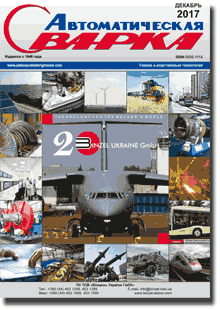| 2017 №12 (01) |
DOI of Article 10.15407/as2017.12.02 |
2017 №12 (03) |

Avtomaticheskaya Svarka (Automatic Welding), #12, 2017, pp. 22-25
Study of properties of welded joint using Dantec’S Istra 4D systems
T. Domanski, W. Piekarska and M. Kubiak
Czestochowa University of Technology
Generala I.N. Dabrowskiego 69, 42-201, Czestochowa, Poland. E-mail:domanski@imipkm.pcz.pl
Abstract
The paper presents displacement and strain fields measured at various stages of tension of flat samples in order to compare the effect of different technological parameters on mechanical properties of welded joints. Results of measurements are also compared with the results of tensile test of the base material to determine the impact of welding process on changes of mechanical properties of tested steel. The measurement of displacements and strains in tensed flat specimens made of S355 steel, hybrid welded using electric arc and laser beam is in the scope of this work. Welding process is performed using Yb:YAG laser and electric arc in GMAW method. D70 Trumpf laser head with maximum power up to 12 kW is used in welding tests with a spot diameter of the laser beam d = 0.8 mm. Welded joints are made for different technological parameters of the process with laser beam heat source leading in the tandem. Tension tests of flat samples are performed in accordance with norm PN-EN ISO 6892-1. Dantec Q-400 ISTRA multi-camera 3D correlation system is used for strain and displacement measurements. The method of measurement is based on the correlation of digital images recorded by the three cameras. Surface of tested samples is covered with a layer of white and black paint. The measurement took place by tracking movements of spots covering the surface of the sample, loaded by longitudinal force. 6 Ref., 4 Figures.
Keywords: hybrid welding, electric arc, laser, welded joints, mechanical properties, tensile tests, deformation fields
Received: 10.11.17
Published: 16.01.18
References
1. Patorski, K. (2005) Interferometria laserowa. Oficyna Wydawnicza Politechniki Warszawskiej, 214–261.
2. Herbst, C., Splitthof, K. Basic of 3D Digital Image Correlation. Ulm, Dantec Dynamics GmbH.
3. Chu, T.C., Ranson, W.F., Sutton, M.A, Peters, W.H. (1985) Application of digital-image-correlation techniques to experimental mechanics. Experimental Mechanics, 25(3), 232–244. https://doi.org/10.1007/BF02325092
4. Gower, M.R., Shaw, R.M. (2010) Towards a planar cruciform specimen for biaxial characterization of polymer matrix composites. Applied Mechanics and Materials, 24–25, 115–120. https://doi.org/10.4028/www.scientific.net/AMM.24-25.115
5. Lord, J.D. (2009) Digital Image Correlation (DIC), Modern stress and strain analysis. A state of the art guide to measurement techniques. BSSM Technical Editors: J. Eaton Evans, J.M. Dulie-Barton, R.L. Burguete, 14–15.
6. Palanca, M., Cristofolini, L. Validation and Optimalization of the parameters of Acquision and Processing For Analysis Through Digital Image Correlation. University of Bologna.
